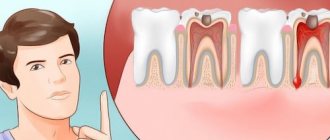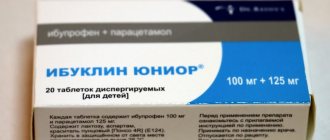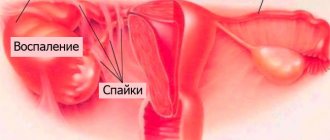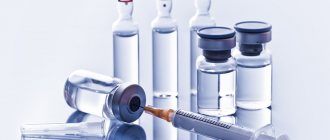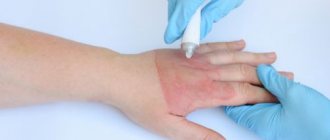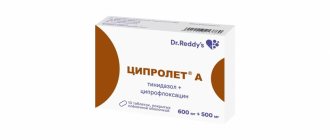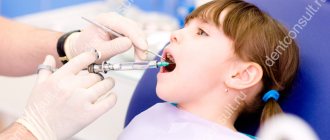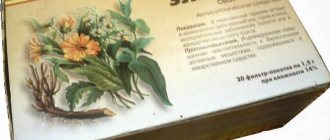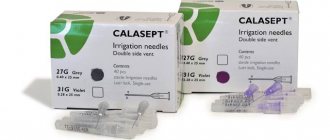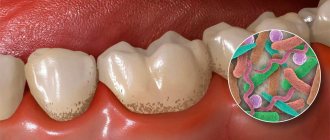NON-STEROID ANTI-INFLAMMATORY DRUGS IN DENTISTRY
Sologova Diana Igorevna Puntovaya Kristina Dmitrievna Federal State Autonomous Educational Institution of Higher Education “First Moscow State Medical University named after. THEM. Sechenov Ministry of Health of Russia" (Sechenov University)
EFFECTIVENESS OF NSAID USE
In terms of the strength of the analgesic effect, Ketorolac is significantly superior to other NSAIDs. The drug does not depress respiration, does not affect opioid receptors, does not cause drug dependence, and does not have a sedative or anxiolytic effect. It is also important that the drug begins to have an analgesic effect within 15–30 minutes. after reception. The drug is recommended for use as a means of pathogenetic and symptomatic therapy in the conservative and surgical treatment of generalized periodontitis. With its use, earlier relief of pain and signs of local inflammatory reaction (swelling and bleeding of the gums) are recorded. The drug is also capable of reducing the rate of bone tissue resorption, incl. and in the presence of microorganisms, which is a significant factor in favor of including the drug in the pharmacotherapy regimen for periodontitis.
In addition, because Ketorolac has high analgesic activity; it is used as an alternative to narcotic analgesics for moderate or severe pain after surgery in the maxillofacial area.
- Ketoprofen is a powerful non-steroidal anti-inflammatory drug.
It relieves pain well and helps with most of these symptoms, and also relieves inflammation in soft tissues. In addition, ketoprofen helps lower the temperature if it is elevated due to some serious pathology. It is used in the form of a rinse solution - symptomatic treatment of inflammatory diseases of the oral cavity, such as stomatitis, glossitis, gingivitis, periodontitis, periodontal disease, for analgesia during the treatment and extraction of teeth (as an auxiliary drug). Ketoprofen relieves pain quite quickly, but this is not enough. It does not affect the cause of the disease (caries, pulpitis or periodontitis). The main danger of the drug is that a person can suppress the pain for a very long time and not go to the doctor, and this will lead to complications both for dental diseases and for the whole body (possible development of dizziness, lethargy, vomiting, nausea, abdominal pain) .
Ketoprofen in the form of a 1% cream, when applied 1.8 ml once a day for 6 months to the gum area of rhesus monkeys with periodontitis, promoted the restoration of alveolar bone and significantly reduced the levels of PGE2 and LT B4 in the periodontal fluid (after 2 and 3 months of treatment ). The drug in the form of a 2% gel, when applied to the gums of patients with chronic periodontitis in addition to instrumental therapy, contributed to a significant reduction in probing depth.
- Nimesulide . Toothache is not a direct indication for taking this drug.
The drug is used primarily for rheumatic diseases that affect the joints and surrounding tissues. The action of the medicine is aimed at eliminating the symptoms of inflammation, which include pain, incl. and dental. But it must be remembered that the effectiveness of Nimesulide depends on the reason for the toothache. In severe dental pathologies, even potent analgesics cannot eliminate the symptom.
It is effective to use the drug for gingivitis, because it eliminates swelling and helps normalize local temperature. The effect after administration is observed quite quickly; on average, it begins to act within 25–30 minutes. The analgesic effect lasts for a fairly long period of time - up to 10 hours.
Important! The medicine is also characterized by a number of disadvantages: it cannot be used during pregnancy and children; it is not intended for long-term use; there is a possibility of addiction; toxic effects on the liver; potential - overdose and poisoning.
- Ibuprofen inhibits the synthesis of prostaglandins, which, in turn, increase the sensitivity of nociceptive receptors.
Due to this, pain is reduced, but the effect is temporary (lasts up to 12 hours). You can take the drug for toothache, but no more than 5 days in a row.
The administration of Ibuprofen to patients with chronic periodontitis after 14 days was accompanied by a significantly more pronounced reduction in bleeding and hyperemia of the gums, as well as the depth of periodontal pockets compared to the group without pharmacotherapy.
Use of NSAIDs:
- for acute pain resulting from advanced caries or pulpitis;
- before hygienic procedures (removal of hard deposits, bleaching), with an increased pain threshold in the patient;
- to relieve pain that occurs after treatment;
- to eliminate pain during the period of getting used to braces, prosthesis and other structures;
- in inflammatory processes in the soft tissues of the oral cavity (periodontitis, periodontitis, stomatitis).
You should not take NSAIDs if:
- intestinal diseases;
- pregnancy more than 24 weeks;
- liver and kidney failure;
- Do not lie;
- blood clotting disorders;
- recently undergone SS operations.
In order to avoid intoxication and negative effects on the gastric mucosa, it is necessary to take the drug after meals.
NSAIDs. GENERAL CHARACTERISTICS
Nonsteroidal anti-inflammatory drugs (NSAIDs) are a group of medications that are widely used in clinical practice, many of which can be purchased without a prescription. More than thirty million people worldwide take NSAIDs daily, with 40% of these patients over 60 years of age. The great popularity of NSAIDs is explained by the fact that they have anti-inflammatory, analgesic and antipyretic effects and bring relief to patients with corresponding symptoms (inflammation, pain, fever), which are observed in many diseases. The use of the term “non-steroidal” emphasizes their difference from glucocorticoids, which have not only an anti-inflammatory effect, but also other, sometimes undesirable properties of steroids.
Over the past 30 years, the number of NSAIDs has increased significantly, and currently this group includes a large number of drugs that differ in their characteristics of action and use.
More than 60 million packages of Ibuprofen and Ketorolac, more than 25 million packages of Diclofenac, and almost 20 million packages of Nimesulide are sold annually in Russia.
The main mechanism of action of NSAIDs is the suppression of the activity of cyclooxygenase (COX), an enzyme that regulates the conversion of arachidonic acid into prostaglandins (PG), prostacyclin (PG12) and thromboxane (TxAg). The nature of the effect of NSAIDs on the COX isoforms—COX-1 and COX-2—is especially important. COX-1 is constantly present in most tissues (albeit in varying quantities) and belongs to the category of “constitutive” (“structural”) enzymes that regulate the physiological effects of PG. COX-2 plays the role of a “structural” enzyme only in some organs (brain, kidneys, bones, reproductive system in women), and is not normally found in other organs. However, the expression of COX-2 increases significantly under the influence of immune mediators (cytokines) involved in the development of the immune response, inflammation, cell proliferation, etc.
Inhibition of COX-2 is one of the important mechanisms of anti-inflammatory and analgesic activity, and COX-1 of the toxicity of NSAIDs. Non-selective NSAIDs inhibit the activity of both COX isoforms to the same extent and therefore have approximately similar effectiveness. This discovery served as the basis for the creation of a new group of NSAIDs that predominantly inhibit COX-2 (selective COX-2 inhibitors). They have all the positive properties of non-selective NSAIDs, but are less toxic, at least in relation to the gastrointestinal tract. Based on their selectivity of action against COX isoforms, NSAIDs are divided into 4 groups (Table 1).
Table 1 Classification of NSAIDs by selectivity of action on COX isoforms
| Group | Active ingredients |
| Non-selective COX inhibitors | Indomethacin, ibuprofen, diclofenac |
| Selective COX-1 inhibitors | Low doses of acetylsalicylic acid |
| Selective COX-2 inhibitors | Coxibs (celecoxib, rofecoxib, valdecoxib, etc.); Meloxicam, nimesulide, etodolac |
| Selective COX-3 inhibitors | Paracetamol, metamizole sodium |
In addition, NSAIDs are classified depending on the severity of their anti-inflammatory activity and chemical structure. The first group includes drugs with a pronounced anti-inflammatory effect. NSAIDs of the second group, which have a weak anti-inflammatory effect, are often designated by the terms “non-narcotic analgesics” or “analgesics-antipyretics” (Table 2).
Table 2 Classification of NSAIDs depending on the severity of anti-inflammatory activity and chemical structure
| NSAIDs with pronounced anti-inflammatory activity | |
| Acids | |
| Salicylates | Acetylsalicylic acid Diflunisal Lysine monoacetylsalicylate |
| Pyrazolidines | Phenylbutazone |
| Indoleacetic acid derivatives | Indomethacin Sulindac Etodolac |
| Phenylacetic acid derivatives | Diclofenac |
| Oxycams | Piroxicam Tenoxicam Lornoxicam Meloxicam |
| Propionic acid derivatives | Ibuprofen Naproxen Flurbiprofen Ketoprofen Tiaprofenic acid |
| Non-acid derivatives | |
| Alcanons | Nabumethon |
| Sulfonamide derivatives | Nimesulide Celecoxib Rofecoxib |
| NSAIDs with weak anti-inflammatory activity | |
| Anthranilic acid derivatives | Mefenamic acid Etofenamate |
| Pyrazolones | Metamizole Aminophenazone Propyphenazone |
| Para-aminophenol derivatives | Phenacetin Paracetamol |
| Heteroarylacetic acid derivatives | Ketorolac |
NSAIDS IN DENTISTRY
According to Orenburg State University, the list of the most commonly used non-steroidal anti-inflammatory drugs in dental practice in tablet form as of 2015 was as follows (Fig.):
- Ketoprofen - prescription frequency 56%, duration of action 6 hours.
- Ketorolac - prescription frequency 20%, duration of action 4-5 hours.
- Nimesulide - prescription frequency 14%, duration of action 5 hours.
- Ibuprofen - prescription frequency 8%, duration of action 4 hours.
- Metamizole sodium - prescription frequency 2%, duration of action 4 hours.
Rice.
In dental practice, NSAIDs are widely used for inflammatory diseases of the maxillofacial region and oral mucosa, inflammatory swelling after injuries, operations, pain syndrome, arthrosis and arthritis of the temporomandibular joint, myofascial pain syndrome of the maxillofacial region, neuritis, neuralgia, postoperative pain, feverish conditions.
Instructions for use METRONIDAZOLE tablets
To avoid the development of resistance of microorganisms, metronidazole should only be used to treat infections caused by metronidazole-sensitive strains (according to microbiological examination of the material or epidemiological data).
Trichomoniasis with clinical symptoms.
Metronidazole is indicated for the treatment of trichomoniasis with clinical symptoms in women and men, if the presence of trichomonas has been confirmed by appropriate laboratory tests (smear and/or culture).
Asymptomatic trichomoniasis.
Metronidazole is indicated for the treatment of women with asymptomatic trichomoniasis (endocervicitis, cervicitis or cervical erosion). Because there is evidence that the presence of trichomonas may interfere with the accurate evaluation of cytological smears, additional smears should be performed after eradication of the parasite.
Treatment of a spouse without clinical manifestations.
T. vaginalis infection is a sexually transmitted disease. Thus, asymptomatic sexual partners should be treated at the same time to prevent reinfection from the partner, even if the pathogen is not isolated. The decision about whether to treat an asymptomatic male partner in whom trichomonas is not detected, or where testing has not been performed, is an individual one. In making this decision, it should be noted that there is evidence that a woman can become infected again if her husband is not treated. In addition, because there are significant difficulties in isolating the pathogen from an asymptomatic patient, negative smear and culture results should not be relied upon. In any case, in case of re-infection, the spouses should be treated with metronidazole at the same time.
Amoebiasis.
Metronidazole is indicated for the treatment of acute intestinal amebiasis (amebic dysentery) and liver abscess caused by amoebae. When treating a liver abscess caused by amoebas with metronidazole, the need for aspiration or drainage of pus cannot be excluded.
Anaerobic bacterial infections.
Metronidazole is indicated for the treatment of severe infections caused by susceptible anaerobic bacteria. Necessary surgical procedures must be performed in combination with metronidazole therapy. In case of mixed aerobic and anaerobic infection, appropriate antimicrobial agents should be used in addition to metronidazole. When treating severe anaerobic infections, metronidazole is usually given first. Intra-abdominal infections, including peritonitis, intra-abdominal abscess and liver abscess, are caused by Bacteroides, including the B. fragilis group (B. fragilis, B. distasonis, B. ovatus, B. thetaiotaomicron, B. vulgatus), Clostridium, Eubacterium, Peptococcus niger and Peptostreptococcus .
Infections of the skin and skin structures,
caused by Bacteroides (including the B. fragilis group), Clostridium, Peptococcus niger, Peptostreptococcus and Fusobacterium.
Gynecological infections,
including endometritis, endomyometritis, tubo-ovarian abscess and infections after gynecological surgery caused by Bacteroides (including B. fragilis group), Clostridium, Peptococcus niger and Peptostreptococcus.
Bacterial septicemia,
caused by Bacteroides (including the B. fragilis group) and Clostridium.
Bone and joint infections
caused by Bacteroides species (including the B. fragilis group) as adjunctive therapy.
CNS infections
including meningitis and brain abscess caused by Bacteroides (including B. fragilis group).
Lower respiratory tract infections,
including pneumonia, empyema and lung abscess caused by Bacteroides (including B. fragilis group).
Endocarditis,
caused by Bacteroides (including the B. fragilis group).
